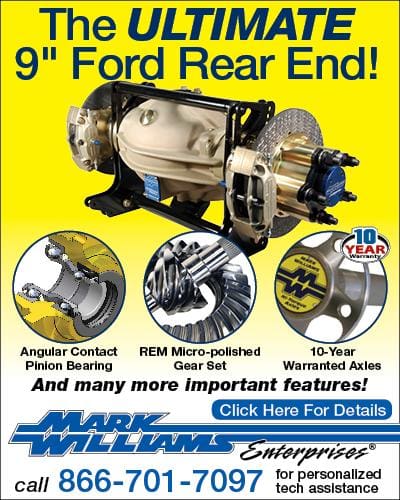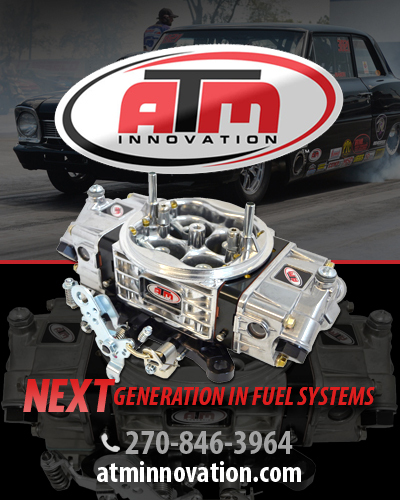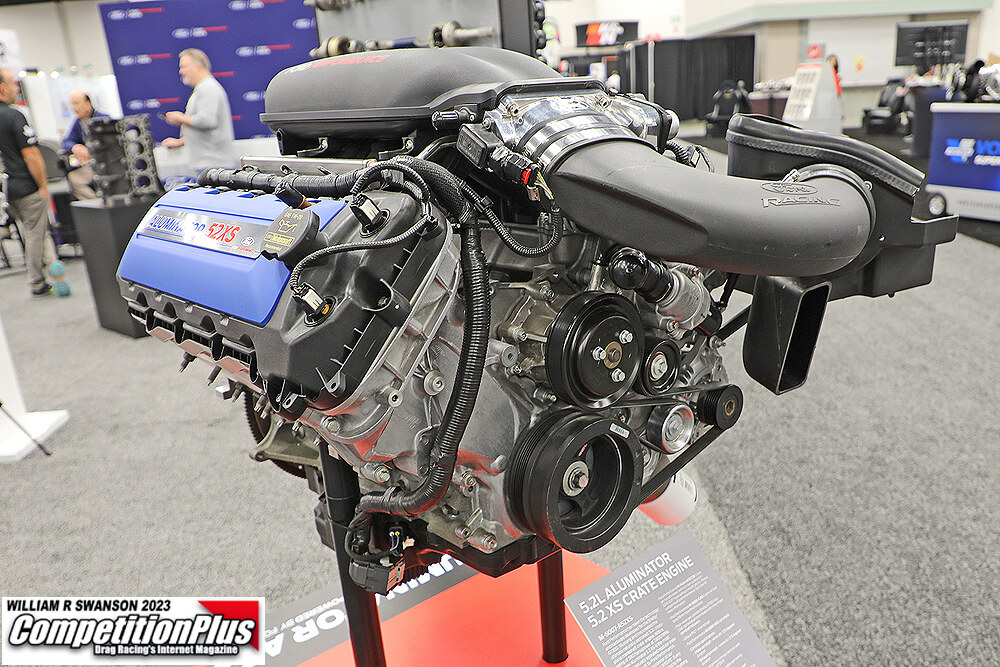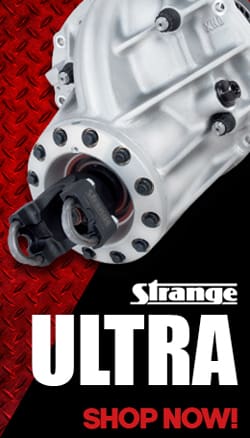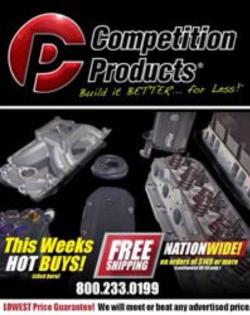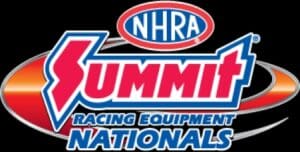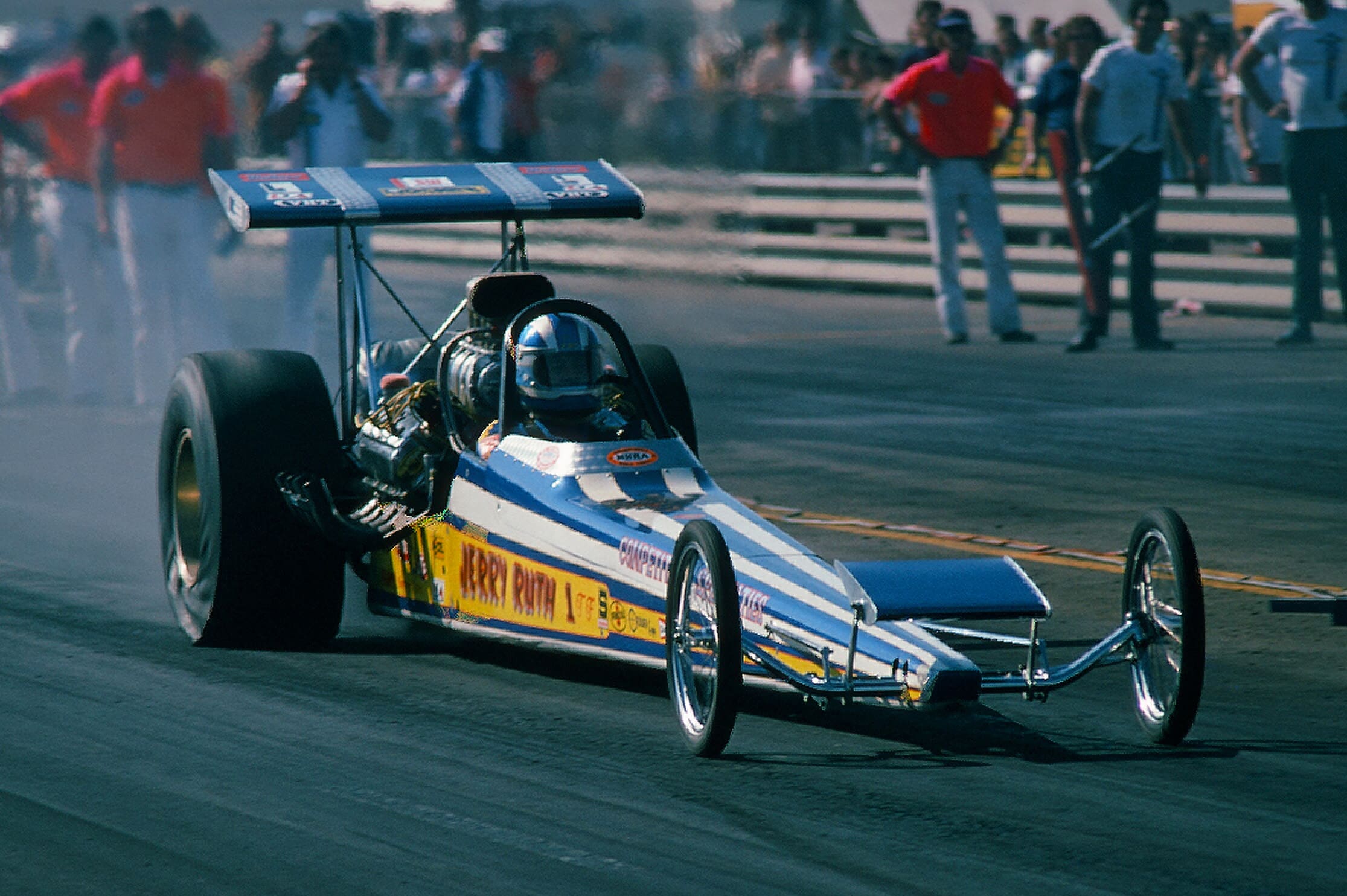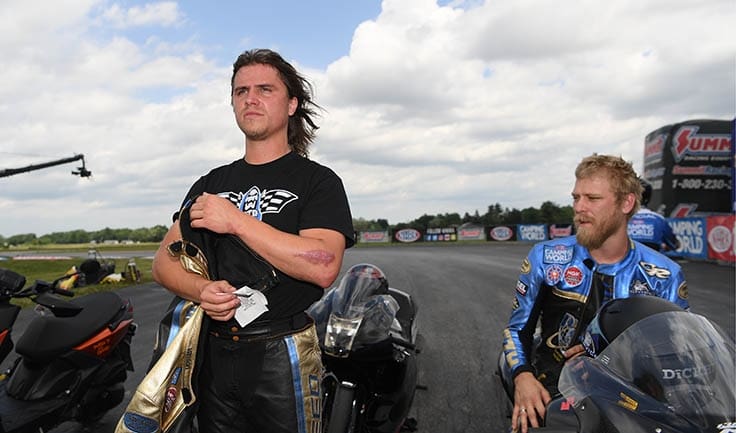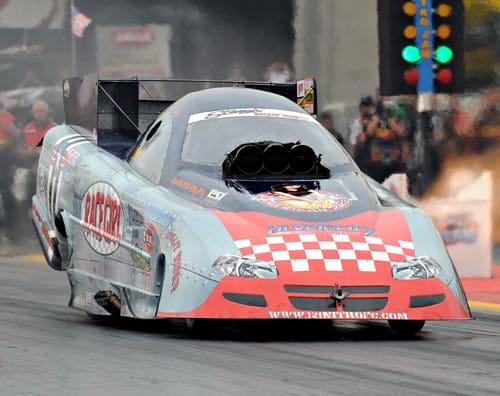 Jason Fiorito, president of Pacific Raceways, grinned and asked, “You know what people remember most about Pacific Raceways, or SIR [Seattle International Raceway]? Whit Bazemore and Jim Rockstad.”
Jason Fiorito, president of Pacific Raceways, grinned and asked, “You know what people remember most about Pacific Raceways, or SIR [Seattle International Raceway]? Whit Bazemore and Jim Rockstad.”
He was referring to the war of words between racer Bazemore and then-track operator Rockstad in 2000 that played out in national TV and in front of fans. Fifteen years later, it is part of the lore surrounding the dragstrip just south of Seattle.
“I still hear that story once a year, like clockwork, at every national event,” Fiorito said last Saturday during the NHRA Northwest Nationals.
But Fiorito had another plan for getting national publicity – all positive – for his family’s 320-acre multiuse property in the shadow of Mount Rainier. He spearheaded a master plan to develop the facility into an “automotive and design technology campus” with global reach.
The idea gained traction and the blessing of the Washington State Legislature, the same body that shooed away NASCAR. It’s clever, relevant, and economically and environmentally beneficial, with its mission to bring together high-tech and automotive companies for advancements in the renewable-energy-vehicle industry and other “green” initiatives. But the land became up for sale. Now it’s not for sale, as Fiorito said he’s sticking to the commitments he made to his supporters.
Here’s what he had to say this past weekend about his renewed focus:
Competition Plus: Pacific Raceway was up for sale but has been off the market for some time now, right?
Jason Fiorito: Probably six months.
CP: Did you not have a reasonable offer? Or did you decide you weren’t ready to part with it after all?
JF: We were looking for the right buyer that saw the vision and was going to devote the resources to moving it to the next level that track deserves. We admittedly have exhausted lot of our resources getting it to this point. We felt like we were, to a certain extent, in the way of the development. But were weren’t just on the market to sell it to anybody. We were looking for the right buyer. And the right buyer didn’t materialize. There was some interest in it as a development: parcel out the place, build housing, all the things we didn’t want to have happen to it. And it wasn’t going to stop being a racetrack on my watch. So we pulled it off the market and have refocused our energies on finding a way to get through environmental review, getting the entitlements that were set up by the legislation in place, and moving forward – hopefully by ourselves, but at that point, we’ll revisit whether there’s interest from other folks that have deeper pockets than us who can move it forward more quickly or whether we can gather the resources to move it forward ourselves. But for now, we’re committed to maintaining it as a racing surface, maintaining it as a venue for the NHRA, and moving forward with the entitlements that were set up by the legislation passed in 2012.
CP: Does that still include the tech center?
JF: Absolutely.
CP: Do those entitlements apply to this property if you don’t decide to follow through with a tech center?
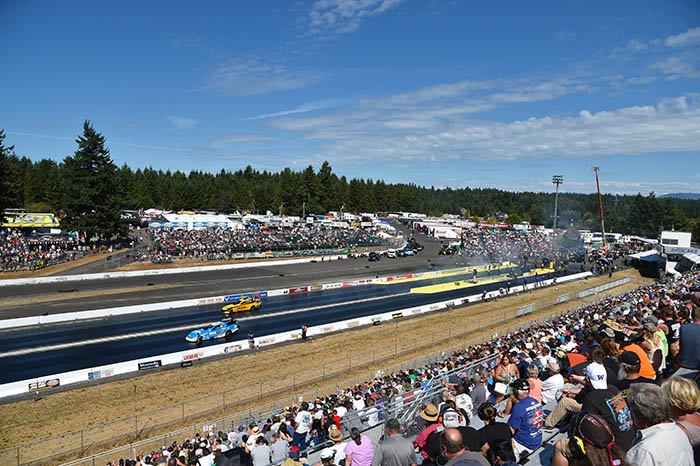 JF: The legislation is only active after environmental review. So the right to put up the buildings and improve the road-course racing surface is contingent upon getting through the $1.5-$2 million process of reviewing the application. Until that happens, we are grandfathered in our existence under the original CUP [conditional use permit].
JF: The legislation is only active after environmental review. So the right to put up the buildings and improve the road-course racing surface is contingent upon getting through the $1.5-$2 million process of reviewing the application. Until that happens, we are grandfathered in our existence under the original CUP [conditional use permit].
CP: And that means you can’t do all those things, right?
JF: Which means we can’t do all those things until we get thought the review. And that’s really the block, because it’s tough to get the $2 million it’s going to take to get through environmental review. The racetrack is expensive. And we’ve experienced an increase in property taxes of over a quarter of a million dollars a years since we got here. We’ve lost over a quarter of a million dollars in revenue because of King County reinterpreting what we’ve been allowed to do over the last 30 years. So there’s been a half-a-million-dollar revenue swing in the last five years due to increased expenses and decreased revenue. That’s been tough to absorb. So we really need the commercial development. It’s hard to borrow money to get through environmental review when you don’t have the current cash flow to debt-service the loan. Very few banks now are loaning on a good idea. They’re all loaning on cash flow. So we’re still actively seeking a partner that will help us through environmental review so that we can get to the point we can put up commercial development that cash-flows the rest of the improvements so that we can make the leap in the racing surfaces that the region deserves.
CP: When you talk about seeking a partner, are you talking about someone who will help bankroll it or someone who wants to come and build, be a cornerstone for this tech-complex development?
JF: We’re interested in talking to anybody about any structure that funds the environmental review and gets us moving forward with the entitlement. Until then, we’re committed to keeping the place a racetrack, maintaining the standards the NHRA requires to put on this event – which is a profitable event. Our walk-up sales were up 23 percent over last year [Friday], and we’re looking at strong attendance today. There was a strong flow of folks coming in all morning. We’re encouraged. Our presales were up by almost 10 percent. The word’s getting out that cars are getting down the track competitively. We broke every record in every class Friday. Eight Pro Stock cars are under the old track record at this point [Saturday], and it looks like if we get some good weather . . . I got here early his morning and it was raining, so I had a little anxiety attack when I rolled through the gate at 11 o’clock. With a little bit of cloud cover and getting the track temperature down into the low 100s or high 90s, we can set the world on fire here this afternoon.
CP: Just about every track has had problems with fans coming but leaving early. Have you spoken with other track operators about some of those issues?
JF: I think a lot of those fans come for one fuel session and then come back the next day, which we encourage. You don’t want to wear out your fans in one day. And if they want to come and see what the racing is going to be like one session and see them rebuild the cars and get home early enough to watch it on TV then come back the next day, we encourage that.
CP: That’s a relevant point. We don’t know that they’re not going to home to watch it on TV. That would mean they can boost the crowd here and help the TV ratings both in one day. That’s a new way to look at it. That’s entirely possible.
JF: Even though it wasn’t hot [Friday], it was sunny all day long. And when you’re out, exposed to the sun, for hours at a time, it can be draining.
CP: Don’t you know that everybody thinks you’re like Bill Gates and can build awnings over all the grandstands and keep everybody in the shade?
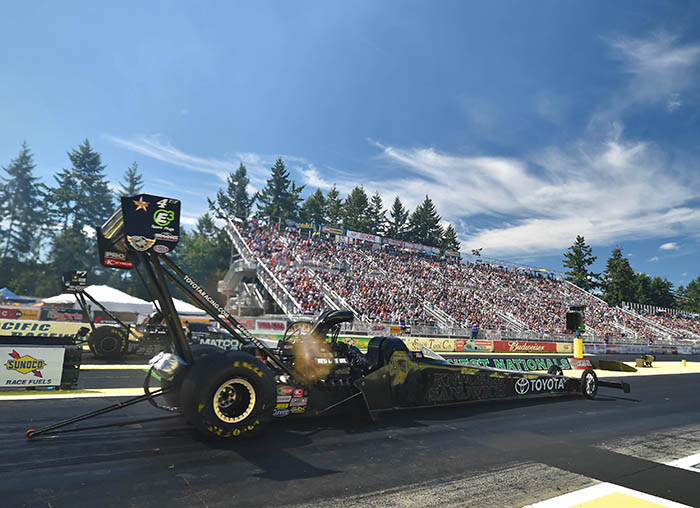 JF: The nice thigs about our aluminum grandstands is that they’re sealed and you can hang out underneath of them to get away from anything Mother Nature throws at you. We’ve got a little bit of share around here. [Friday] has never been our strongest day. Notoriously, Saturday is the most well-attended day at this track. It seems like Friday has always been the easiest day for a spectator to come in, get parked, see everything they need to see, and leave efficiently because they’re not competing with as many fans. We’d love to figure out how to get more folks in on Friday. But it’s been the best bang for your buck in Seattle, because you pretty much have the run of the place when you show up on Friday. Saturday has always been a great show.
JF: The nice thigs about our aluminum grandstands is that they’re sealed and you can hang out underneath of them to get away from anything Mother Nature throws at you. We’ve got a little bit of share around here. [Friday] has never been our strongest day. Notoriously, Saturday is the most well-attended day at this track. It seems like Friday has always been the easiest day for a spectator to come in, get parked, see everything they need to see, and leave efficiently because they’re not competing with as many fans. We’d love to figure out how to get more folks in on Friday. But it’s been the best bang for your buck in Seattle, because you pretty much have the run of the place when you show up on Friday. Saturday has always been a great show.
CP: You had great race in 2014 [and the 2015 version was even better for the fans with records falling and Jack Beckman’s quickest pass in Funny Car history]. No one last year or this year has been complaining about bumps or the lanes or the racing surface. It still has its own idiosyncrasies, but it has improved, the consensus seems to show.
JF: The feedback from the drivers is that our racing surface is competitive with the better racing surfaces across the country. I have a chance to talk to Lanny [so-called “track whisperer” Miglizzi] every year, and there have been years where my conversation with Lanny hasn’t been the most pleasant conversation in the world. But it’s getting better, and it’s consistent. It didn’t move at all between last year and this year, according to Lanny. He was impressed with the consistency from year to year.
CP: We heard a lot of positive comments last year. Competition Plus has been rough on you and Pacific Raceways in the past. Every track operator has things it needs to improve, and you do, too. But it takes a lot of money.
JF: Absolutely. My general manager, John Ramsey, is doing an amazing job. John has been at the helm for three years now, and the event is flowing as well as it ever has. Fans are getting in and out. He spent a lot of time coordinating parking this year. So parking is working more fluidly than it ever has.
CP: Your plans to develop the tech center on the property actually is a brilliantly unique, forward-thinking idea. If you can get the necessary parties to help your vision come true, it’s a coup among racetrack owners. However, it seems to become thorny when you talk about selling the property or a stake in the property only to somebody who shares your vision and promises to carry out your wishes. It’s like envisioning home improvements that will make your house the Taj Mahal but saying, “I can’t afford to upgrade all these features, so I’ll sell it. But the person who buys it has to make all the home improvements I’m envisioning.” You can’t sell your pace to somebody and tell him he has to share your vision. You can’t do that.
JF: Actually, I can.
CP: How so?
JF: I get to choose whether I get to make a deal with somebody.
CP: They also can tell you whatever you want to hear, then carry out their own plans for the property.
JF: They can. But I’m going to consider myself perceptive enough to look at somebody and their background and how they’ve conducted themselves before to know whether they share the vision.
CP: So you’re saying you’re going to do due diligence.
JF: I’m going to do my due diligence. I have promises to the elected officials that supported the legislation and the community at large that I’m going back a project that has regional economic and social benefits. If I sell it to somebody that doesn’t share my vision, then I’ve backed away from my commitment to the elected officials that supported me and the community that has backed me. And that would be disingenuous of me. So my commitment to the folks who have backed me is to follow through with – albeit more slowly than anybody hoped, including me – a project the region can be proud of, that the racers can be proud of, that the fans can be proud of and that is in line with what I’ve promised.
CP: Some would say, “Take the money and run.”
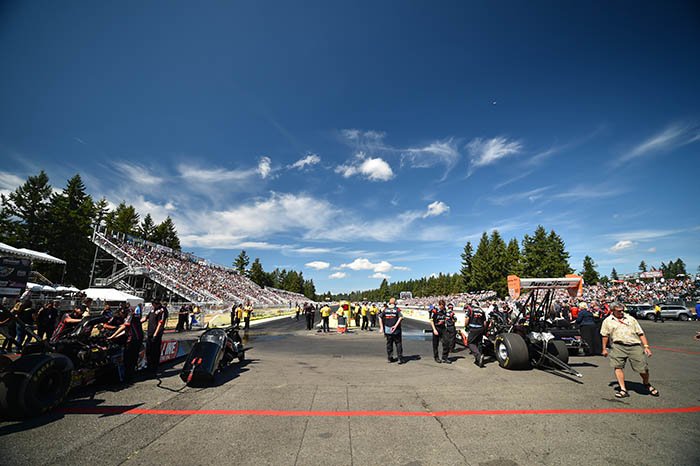 JF: If I were Donald Trump, I would do what, as he has stated over and over again, is good for him, his family, and his business. But I’m part of this community. My grandfather started this racetrack back in 1959. I have a philosophical aversion to not following through with what I committed to the elected officials and the supporters of the track that I was going to provide as an asset for the region. If ultimately that costs me and my family some money to follow through with our commitment, then it costs me and my family some money. I have to look at myself in the mirror every day, and I’m part of a community that considers the racing folks my family. And I can’t turn my back on the folks that rely on this for their enjoyment and the hundred or so businesses that rely on the region having a racetrack to survive. It’s not just me in a vacuum here. If you look at any economic impact studies surrounding any track in the nation, you see that racetracks don’t exist in a vacuum. There’s an entire support system, an entire industry, that survives because of it. When you operate a racetrack, you have a responsibility to be part of the industry that’s helping support you.
JF: If I were Donald Trump, I would do what, as he has stated over and over again, is good for him, his family, and his business. But I’m part of this community. My grandfather started this racetrack back in 1959. I have a philosophical aversion to not following through with what I committed to the elected officials and the supporters of the track that I was going to provide as an asset for the region. If ultimately that costs me and my family some money to follow through with our commitment, then it costs me and my family some money. I have to look at myself in the mirror every day, and I’m part of a community that considers the racing folks my family. And I can’t turn my back on the folks that rely on this for their enjoyment and the hundred or so businesses that rely on the region having a racetrack to survive. It’s not just me in a vacuum here. If you look at any economic impact studies surrounding any track in the nation, you see that racetracks don’t exist in a vacuum. There’s an entire support system, an entire industry, that survives because of it. When you operate a racetrack, you have a responsibility to be part of the industry that’s helping support you.
CP: At some point, you might decide, “This property and all that’s happening with it is a big millstone around my neck” and want to wave the white flag. Have you ever felt like that?
JF: At some point, reality may interject itself and something may be forced on me against my will because of economic conditions that aren’t happening right now.
CP: How much can any family or bank account stand?
JF: It’s been a challenge on our family for 10 years to support operational losses. Now, we haven’t experienced operational losses every year. [The year] ’08 hit us pretty hard, like it did any business that survives off of discretionary income. But we’ve had years that have done very well. We’ve had years that have been tough to endure. We’re trending back with increased attendance at this event, increased rental on the road course, increased revenue streams from sponsorship, and all the surrounding businesses. Our rider count at [the] motocross [track] is up over 300 again. Lance Smail is doing a great job over there, managing the motocross track. He has built a beautiful Friday night program that is commanding over 300 riders. Our car count on the dragstrip, for our weekly drag-racing events, is up over 200, sometimes approaching 300. We simply need the ability to put up garages and rent some of this space out by the square foot. And this thing will operate in the black for the forseeable future.
CP: Do you look at this as more of a dragstrip or a road course?
JF: I look at this as a multi-use motorsports facility. We are a dragstrip, a road course, a motocross track, and a karting track. Were a racing family that embraces all forms of motorsports, although some of them have been taken away from us. We lost the ability to drift here, because the county doesn’t consider drifting a motorsport. They said it wasn’t in existence in 1984, when the plot plan was applied to the conditional use permit. Sometimes I have challenges understanding why the county has taken some revenue streams away from us.
CP: Do they want you to survive or do they not want you to survive?
JF: I think that’s a fair question, at different levels of the county, whether there is a desire to have a racetrack in King County. I think the elected official who have supported us in the past strongly believe in the economic engine and the social benefits of providing a safe alternative to street racing and a family-friendly sporting environment that is true economic engine. I think not all folks employed by the county share that realization.
CP: Would a massive “Race The Strip and Not The Street”-type of campaign give you some leverage?
JF: I don’t know that anything is going to change a permitting official’s mind about the benefits of a racetrack when it seems like some of them are so entrenched in the ideology that we’re a nuisance.
CP: It’s more than a nuisance to have people racing on the street, endangering everybody, including themselves.
JF: I firmly believe that racetracks are an integral part of a community, in terms of providing a safe alternative for kids who inevitably are going to test their ability in automobiles and motorcycles. I believe we’re a strong economic engine. I believe we have social benefits that outweigh the noise created by activities that are experienced by people who decided to buy a house next to a racetrack and make it their life’s work to shut me down. It is not an unusual model nationally to have a racetrack that was built out in the middle of nowhere and urban sprawl encroaches on the racetrack’s boundaries. Folks that just moved in are very vocal, organize themselves very well, and gain the ear of enough staff members that it squeezes racetracks out. We have some neighbors who have been fighting this place for over 30 years. I would have a hard time being as angry with my neighbor for 30 years as some of them have been without deciding just to go someplace else that made me happier to live. I’m not going to fold up my tents easily. We’ve proved that as a family over the last 54 years of continuing to exist here.
CP: You mitigate their concerns by observing curfews, talking with them, trying to be a responsible and friendly neighbor. And for a while you were making some notable progress.
JF: We were.
CP: What happened?
JF: There have been some neighbors who have moved in recently who have been successful at convincing some folks at the county that racetracks are a nuisance.
CP: An urban legend, which might have some truth to it or might be a complete fabrication, has it that one track owner with that same problem paid the neighbors’ taxes for a few years.
JF: It’s hard to go absorb additional expenses without an increase in revenue on a business that’s already losing money. I think it sets a precedent no track would be able to afford. If you started paying individual homeowners not to fight your right to exist, pretty soon you’re going to be paying everybody within a 10-mile radius. They’re going to find out you’re paying for silence. It’s an unsustainable role model. If there was one neighbor who was creating all your issues, you might be able to go make a deal with somebody to make them more comfortable of the existence of you next door. But this is a case of developments to the east, developments to the north, urban sprawl encroaching on the boundary of a racing facility that has been here since 1960 and efficiently influencing King County. We have been systematically robbed of income and saddled with more expense to the point there has been a half-a-million-dollar swing in that revenue.
CP: That’s a whopping amount. That’s significant.
JF: To a business that best-case scenario, cash flow’s a couple hundred thousand dollars a year, it’s the difference between being in the black and pretty significantly in the red.
CP: When NASCAR got a resounding kick in the butt from two Washington State counties (Snohomish and Kitsap) and then the State Legislature, did you feel like you had been punched, too, even though you and your property were in no way involved with a potential NASCAR-track project? Did your heart sink, too, because of the short-sightedness of decision-makers in Washington State?
JF: I would love for this region to understand the benefits, economically and socially, of having a strong racing industry. Historically it hasn’t been in our wheelhouse. Other regions of the country have done very well, even in tough economic times, with the additional engine created by a strong racing industry.
CP: If they did their due diligence, they would understand that.
JF: It comes from a lack of education about the benefits and the strengths of an industry that provides thousands and thousands of jobs nationally and hundreds of millions of dollars in economic benefit. It has been frustrating. I think the region should invite all types of sports and support all kinds of activities. I just want to be included.
CP: At some point you would have to say enough is enough, wouldn’t you?
JF: I’m sure there are some folks who would love me to give up. And that gives me the incentive not to.
The act of cutting and pasting articles from this publication to a message board is a clear copyright violation as is pulling photos to post on social media sites. All articles and photography published in CompetitionPlus.com are protected by United States of America and International copyright laws unless mentioned otherwise. The content on this website is intended for the private use of the reader and may not be published or reposted in any form without the prior written consent of CompetitionPlus.com.










